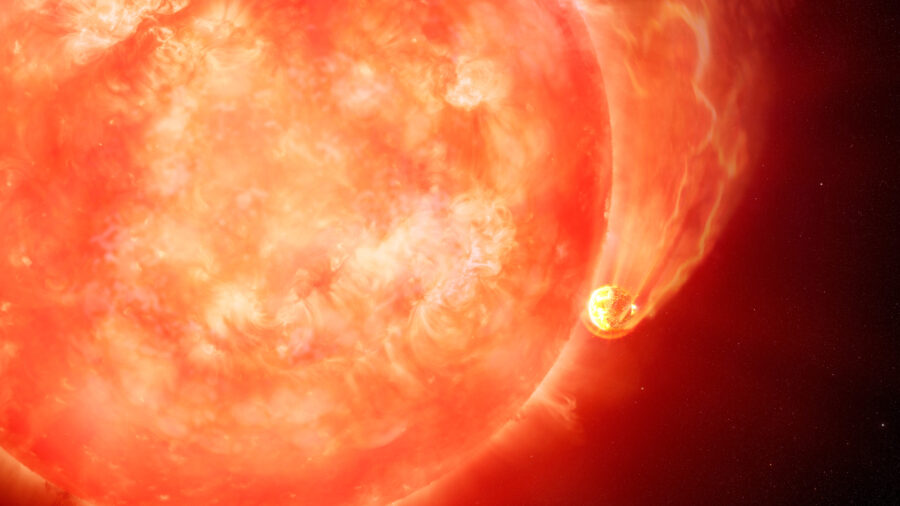For the first time, astronomers have witnessed a star eat an exoplanet.

International Gemini Observatory / NOIRLab / NSF / AURA / M. Garlick / M. Zamani
The dinner bell has struck for a star in the constellation Aquila, the Eagle. Reporting in the May 4th Nature, Kishalay De (MIT) and a team of astronomers watched the star belch and brighten in a way that suggests it swallowed a closely orbiting planet.
The star in question is a nondescript Sun-like star about 12,000 light-years away. Pre-outburst observations indicate it was slightly bloated, perhaps twice as wide as the Sun, and entering its golden years. This time in a star’s life can be a dangerous one for planets. As the star finishes fusing the hydrogen in its core, it brightens and swells. Eventually, it can swell enough to engulf the closest worlds, destroying them in a fiery furnace.
Observations indicate that 30% of all Sun-like stars in our galaxy will eat at least one planet as they evolve. This includes our own Sun, which in several billion years will balloon to envelop Mercury, Venus, and, perhaps, Earth — although astronomers disagree about whether our planet will skirt destruction. (It will certainly be burnt to a crisp, even if the rock itself survives.) The future victims also include roughly 90% of all the exoplanets we’ve detected so far, most of which nestle close to their stars.
But a planet-gorging star was not what De set out to find. De was searching for brilliant blasts from the remnants of Sun-like stars (a.k.a. white dwarfs), which make the star blaze thousands of times brighter than usual. As he trawled through survey data from the Zwicky Transient Facility (ZTF) at Palomar Observatory in California, though, he stumbled upon a star that had brightened by a factor of a few hundred over the course of 10 days. Follow-up spectra revealed this “wimpy” outburst had released cool gas, not the hot gas that comes with the thermonuclear explosions he was seeking.
Baffled, De and his colleagues turned to infrared observations, which pick up cold stuff. These data, taken a few months after the outburst, revealed that a cloud of dusty gas surrounded the star. Digging into archival data, the astronomers also found that the star had started shedding dust a few months before the outburst ZTF caught.
This behavior looked surprisingly like a red nova, a class of stellar flare-ups thought to occur when two stars merge. Astronomers have a handful of examples in the Milky Way; the quintessential one is V1309 Sco, which observers actually witnessed conjoin back in 2008. But red novae are hundreds or even thousands of times brighter than this flareup, called ZTF SLRN-2020.
How bright a merger event is depends on the ratio of the masses of the two objects that merge. If the outburst was a thousandth as bright as expected, it must have involved an object a thousandth as big as the star, the team reasoned. That left a planet — specifically, a gas giant.
Based on extensive comparisons with simulations, the astronomers think the star ate a world roughly 10 times Jupiter’s heft, which orbited the star about once a day. As the planet was engulfed by the expanding star, it plowed through the star’s outer atmosphere, throwing material out that cooled and formed dust, causing the initial infrared uptick. The atmosphere dragged on the planet, slowing it down and forcing it deeper. After a few days, it succumbed and plunged into the star, ejecting a bunch of gas seen as the ZTF outburst that then cooled to endure as a dusty cloud glowing in infrared.
“I was really struck by the timeliness and significance of this work,” says Melinda Soares-Furtado (University of Wisconsin, Madison), who studies what happens when stars eat planets. “The scientific evidence hinting at a planetary engulfment event is quite compelling.” Given the world’s mass, it may have dove fairly deep, even reaching below the star’s outer convective zone before disintegrating, she adds.
Romuald Tylenda (Nicolaus Copernicus Astronomical Center, Poland), who with others demonstrated that V1309 Sco was a stellar melding, agrees that the extensive observations and thorough analysis are persuasive. “Yes, I am (almost) convinced that ZTF SLRN-2020 is likely to have resulted from a star-planet merger.”
Astronomers have previously seen chemical fingerprints in stars’ atmospheres that appear to be planetary debris, and they’ve also seen stars oddly spun-up — which could happen if the star ate a planet. But they haven’t caught a star in the act of feasting before.
It would be difficult to see this star’s change in rotation, De says, but they may be able to spot the crumbs in the stellar atmosphere. The team already has JWST data in hand to look for precisely that.
For now, it appears the star has settled back down to its former self, “like the star ate that planet and forgot about it completely,” De says. Given that the planet was so much smaller than the star, that’s unsurprising. “I eat a planet and then move on to my next day.”
Reference:
Kishalay De et al. “An infrared transient from a star engulfing a planet.” Nature. May 4, 2023.
P.S. For curious readers, the outburst’s coordinates were RA 19:09:39.783, Dec +05:35:04.269 (because I know you’ll ask).
 0
0
Comments
You must be logged in to post a comment.